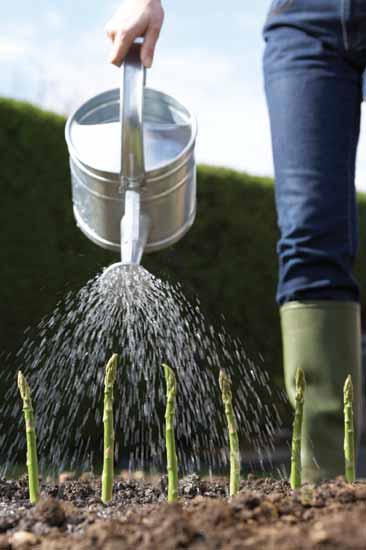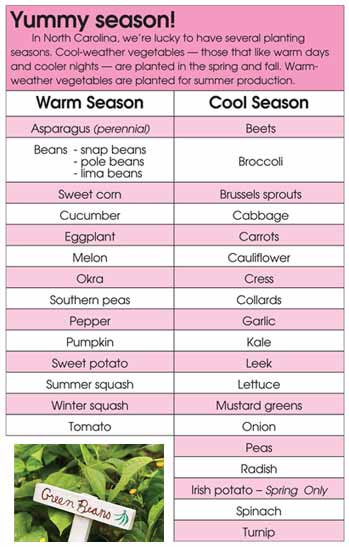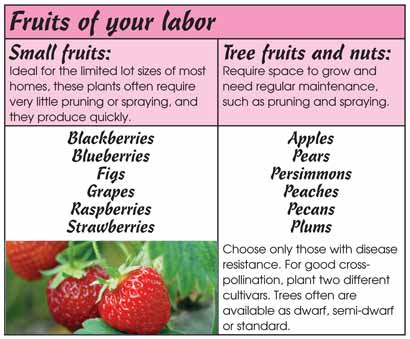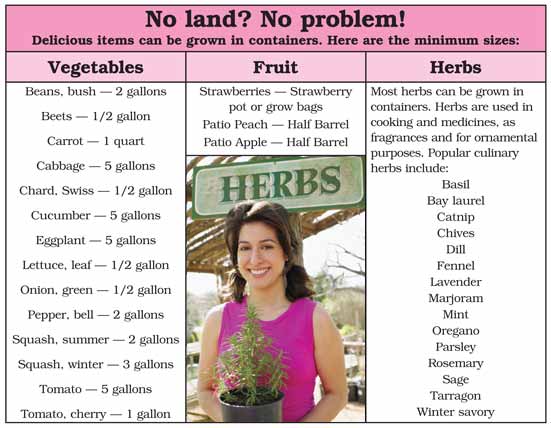 Grow what you eat
Grow what you eat
Gardening for gourmets
Thinking about growing a victory garden? Fabulous! Gardening is the world's most popular activity. Among other positives, growing your own produce is fun and healthy. Consider these reasons to get your hands dirty:
• Gardening is great exercise, burning 250 to 400 calories per hour (depending on your intensity). Instead of being a couch potato, you can care for a potato and a tomato!
• Gardening relieves stress and relaxes your mind.
• Gardening draws you into nature.
• Gardening satisfies the human instinct to nurture.
• Gardening results in products that are typically superior in taste and quality to those in the grocery store.
• Gardening brings beauty into your world.
Your oasis can support a healthy lifestyle. Consume its bounty as part of your healthy eating plan and include a daily visit in your workout program.
When you plan and use good cultivation practices, any bit of soil will grow into a productive vegetable garden. No matter what kind of space you have, you can do yourself proud. Amazingly, you can feed a family on a patch as small as 25 square feet!
You can grow your own food even if you live in a condo or apartment by using containers on the patio or deck. Many containers can become small gardens with a little creativity. Try half barrels, bushel baskets, 5-gallon tubs or window boxes.
For those with disabilities, raised beds help make working the land possible. 
Site
All vegetables, herbs and fruit need six to eight hours of direct sunlight each day, but make sure your sunny spot is convenient, easy to reach and near a water source.
Choose a well-drained tract to plant. Loamy soil is ideal for most fruit and vegetables because it is fertile, drains well and is high in organic matter. Improve the ability of water to enter the soil by adding compost or well-rotted leaves.
Raised beds permit backyard farmers to control the type of soil plants grow in, allowing you to nurse vegetables, herbs and fruit even in poor soil conditions. Raised beds generally improve drainage, but since they warm up and dry out faster than in-ground gardens, you’ll need to water them more often.
Consider incorporating vegetables, herbs and fruit into your ornamental plantings. Edibles in the landscape are both functional and attractive.
If you have limited ground, set vegetables in containers or window boxes. Be sure receptacles have adequate sunlight, proper drainage holes, good soil mixture and ample room to hold the roots of mature plants.
Plan
Designing your fruit, vegetable and herb garden is important. Fruit plants are permanent so carefully choose the location. Select the vegetables and herbs you want to establish, then diagram the space where you will settle them, including spacing between plants.
Use a journal to note time of planting, the weather and any obstacles encountered. This information will be invaluable when planning next year’s crop.
Before planting, complete a soil test and find out the pH of your soil. The ideal pH for most vegetables is 6.0 to 6.5. You can pick up a test kit from your local N.C. Cooperative Extension Center or your local garden center.
 The results will indicate whether to add lime and, if so, the amount. Test your soil’s pH at least every three years.
The results will indicate whether to add lime and, if so, the amount. Test your soil’s pH at least every three years.
Vegetables grow at different temperatures. There are cool-season crops and warm-season crops. Seeding and transplanting times may differ based on temperature.
To do the job right, follow the suggested planting dates and days to maturity for the food you plan to put on your table.
Maximize your plot by planting a spring, summer and fall garden. This involves well-planned succession planting in locales vacated by spent plants.
Interplanting is the technique of growing two or more types of vegetables in the same place. For example, smaller plants placed close to larger plants or quick maturing plants placed with slower maturing plants.
Crop rotation is important to prevent the buildup of insects and diseases. Rotating crops also helps keep vital soil nutrients from being depleted. Don’t place veggies from the same family in the same garden location more than once every three years. Be sure to properly fertilize your garden in order to replace depleted nutrients.
Maintain

• Water
Douse your edible garden so it flourishes. Most fruit and vegetables require at least 1 inch of water per week, which is about 75 gallons of water per 100 square feet.
It’s best to water slowly, allowing the stream to sink in deeply, rather than using a short, fast drizzling technique that may only wet the surface and run off. Try to dampen the soil to a depth of 6 inches.
A soaker hose is the least expensive and easiest way to water effectively. The soaker hose or a drip irrigation system delivers small amounts of water to the soil very slowly.
• Fertilize
The quality of your plants — and their yield — begins with your soil. To boost nutrients, add a 2- to 3-inch layer of organic matter, such as rotted leaves, compost or old manure, in the spring before you prepare the soil and again in the fall after harvest.
Prior to planting, incorporate 20 to 30 pounds of 10-10-10 fertilizer per 1,000 square feet (or the recommended rate from your soil test results).
After planting, long-season vegetables, such as tomatoes, peppers and cucumbers, need at least one side dressing of 3 cups 10-10-10 fertilizer per 100 square feet. Apply 4 to 6 inches of fertilizer around the plant to maximize nutrients.
Protect
Pest management may seem overwhelming, but a few simple practices will reduce or prevent many problems. Properly fertilizing and watering plants, eliminating weeds, and removing diseased and rotting fruits will make your garden happy.
Start by keeping the area well-maintained and weed-free.
Remove overripe produce to prevent scavenger-type insects from visiting your haven. Removal of disease-infested plants can help prevent further spread of the scourge. Take the distressed plants completely out of the bed and discard them.
Weeds provide homes for insects and diseases. Plus, they compete with your beauties for nutrients, water and sunlight.
Mulching decreases the amount of weeds in the garden while also conserving water. Organic mulches, such as bark chips, straw, leaves, newspaper and compost, decompose naturally in the soil over time.
A hoe is an effective weapon in the weed war.
Hand-weeding is good for getting bad guys that are close to the base of a plant. Try to remove weeds while they are small since pulling large ones can damage the root systems of vegetable plants.
The authors were all with N.C. Cooperative Extension. An earlier version of their article appeared in Cooperative Extension’s “Successful Gardener.”